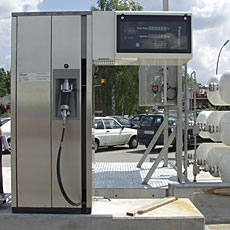Clean urban public transport with fuel cell buses and hydrogen as a fuel
A high level of pollution and noise emissions by road traffic is widely seen as the central environmental problem in all major cities.
The objective of the project CUTE (Clean Urban Transport for Europe) was a comprehensive trial of fuel cell buses, using hydrogen as a fuel. Buses running on fuel cells are not only significantly quieter than those running on diesel, but also emit water vapour only. The project was coordinated by EvoBus, a DaimlerChrysler subsidiary.
Between mid/end 2003 and December 2005, three buses each were in daily operation in nine major European cities, from Stockholm to Porto. Their performance was tested under sometimes challenging conditions (hot summers in the south, cold winters in the north, hilly landscape in Stuttgart or Barcelona, heavy traffic with stop-and-go in London etc.).
Also part of the project were economic and ecological studies. The use of hydrogen and fuel cells and its advantages for the environment compared to conventional buses were investigated and scenarios for cost reduction of cars and fuelling stations through mass production were prepared.
PLANET's role
PLANET led the work package concerned with implementation and operation of the hydrogen fuelling stations. Thy were planned, approved and build in the first phase of CUTE (end of 2001 to mid/end of 2003) and were in service for two years at each of the sites. Operating data were being logged daily and analysed.
The hydrogen was produced on site in most of the cities, hence, forming a part of the hydrogen infrastructure themselves. Mostly electrical power from renewable energies was used to split water into its constituents hydrogen and oxygen in a process called electrolysis (in Stockholm, Hamburg, Amsterdam, and Barcelona). In other cities (Stuttgart and Madrid) hydrogen was produced from natural gas (methane) in a process called steam-reformation. As natural gas is a fossil fuel, this process still emits (fossil) carbon dioxide.
The the other sites (London, Luxemburg, and Porto) received their hydrogen via lorries from external plants which produce the hydrogen from fossil sources as well.
It was the intention to choose these various ways of hydrogen supply to test the performance of different systems in regard to technical availability, energy efficiency, complexity of maintenance, purity of the hydrogen etc.
Amongst the 28 partners, including global players such as BP or HEW, PLANET was one of the few smaller partners who contributed to CUTE.
The high expectations of the project could be fulfilled. It was completed with great success in May 2006. Most of the sites have resumed operation in the follow-up project HyFLEET:CUTE.


